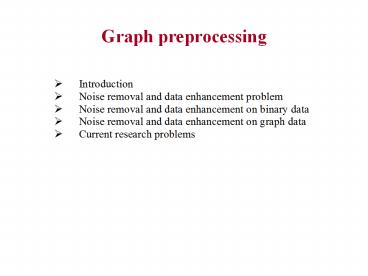Graph preprocessing PowerPoint PPT Presentation
1 / 15
Title: Graph preprocessing
1
Graph preprocessing
2
Introduction
3
Introduction
4
Introduction
5
Protein Function and Interaction Data
6
Problems with Available Interaction Data (I)
- Noise Spurious or false positive interactions
- Leads to significant fall in performance of
protein function prediction algorithms Deng et
al, 2003
Hart et al,2006
7
Problems with Available Interaction Data (II)
- Incompleteness Unavailability of a major
fraction of interactomes of major organisms - Yeast 50, Human 11
- May delay the discovery of important knowledge
Hart et al, 2006
8
Introduction
9
Introduction
10
Data cleaning techniques at data collection stage
11
Purpose of data cleaning techniques data analysis
view point
12
Purpose of data cleaning techniques data analysis
view point
13
Data cleaning techniques at the data analysis
stage
14
Neighbourhood-based approaches for graph
transformation
15
References (I)
- Pandey et al, 2006 Gaurav Pandey, Vipin Kumar
and Michael Steinbach, Computational Approaches
for Protein Function Prediction A Survey, TR
06-028, Department of Computer Science and
Engineering, University of Minnesota, Twin Cities - Pandey et al, 2007 G. Pandey, M. Steinbach, R.
Gupta, T. Garg and V. Kumar, Association
analysis-based transformations for protein
interaction networks a function prediction case
study. KDD 2007 540-549 - Xiong et al, 2005 XIONG, H., HE, X., DING, C.,
ZHANG, Y., KUMAR, V., AND HOLBROOK, S. R. 2005.
Identification of functional modules in protein
complexes via hyperclique pattern discovery. In
Proc. Pacific Symposium on Biocomputing (PSB).
221232. - Xiong et al, 2006a XIONG, H., TAN, P.-N., AND
KUMAR, V. 2003. Hyperclique Pattern Discovery,
Data Mining and Knowledge Discovery,
13(2)219-242 - Xiong et al, 2006b XIONG, H., PANDEY, G.,
STEINBACH, M., AND KUMAR, V. 2006, Enhancing Data
Analysis with Noise Removal, IEEE TKDE,
18(3)304-319 - Xiong et al, 2006c Hui Xiong, Michael
Steinbach, and Vipin Kumar, Privacy Leakage in
Multi-relational Databases A Semi-supervised
Learning Perspective, VLDB Journal Special Issue
on Privacy Preserving Data Management , Vol. 15,
No. 4, pp. 388-402, November, 2006 - Xiong et al, 2004 Hui Xiong, Michael Steinbach,
Pang-Ning Tan and Vipin Kumar, HICAP
Hierarchical Clustering with Pattern
Preservation, SIAM Data Mining 2004 - Tan et al, 2005 TAN, P.-N., STEINBACH, M., AND
KUMAR, V. 2005. Introduction to Data Mining.
Addison-Wesley. - Nabieva et al, 2005 NABIEVA, E., JIM, K.,
AGARWAL, A., CHAZELLE, B., AND SINGH, M. 2005.
Whole-proteome prediction of protein function via
graph-theoretic analysis of interaction maps.
Bioinformatics 21, Suppl. 1, i1i9. - Deng et al, 2003 DENG, M., SUN, F., AND CHEN,
T. 2003. Assessment of the reliability of
proteinprotein interactions and protein function
prediction. In Pac Symp Biocomputing. 140151. - Gavin et al, 2002 A. Gavin et al. Functional
organization of the yeast proteome by systematic
analysis of protein complexes, Nature,
415141-147, 2002 - Hart et al, 2006 G Traver Hart, Arun K Ramani
and Edward M Marcotte, How complete are current
yeast and human protein-interaction networks,
Genome Biology, 7120, 2006

